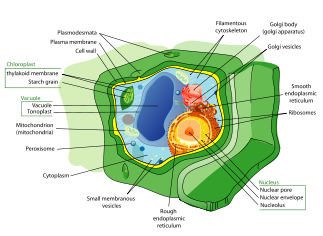Plant cell
2007 Schools Wikipedia Selection. Related subjects: General Biology
Plant cells are quite different from the cells of the other eukaryotic kingdom's organisms. Their distinctive features are:
- A large central vacuole (enclosed by a membrane, the tonoplast), which maintains the cell's turgor and controls movement of molecules between the cytosol and sap.
- A cell wall made up of cellulose and protein, and in many cases lignin, and deposited by the protoplast on the outside of the cell membrane. This contrasts with the cell walls of fungi, which are made of chitin, and prokaryotes, which are made of peptidoglycan.
- The plasmodesmata, linking pores in the cell wall that allow each plant cell to communicate with other adjacent cells. This is different from the network of hyphae used by fungi.
- Plastids, especially chloroplasts that contain chlorophyll, the pigment that gives plants their green colour and allows them to perform photosynthesis.
- Plants lack centrioles that are present in animal cells.
Like other eukaryotic cells, plant cells typically also have a nucleus, containing most of the cell's DNA, and mitochondria, the 'power plants' of the cell. However, some parts of a living plant's tissue are selectively dead so they can serve the plant without consuming vital nutrients.
Tissue types
These three major classes of cells can then differentiate to form the tissue structures of roots, stems, and leaves. Plants have these types of tissues and they have similar locations within all species of plants. However, the amount of these tissues will vary for different plant species.
The three distinct types of plant cells are classified according to the structure of their cell walls and features of their protoplast. Plants will have a primary cell wall and sometimes a secondary wall as well. These two major parts are what determines the function of each individual plant cell.
- Dermal tissue - the outer most covering of a plant.
- Vascular tissue - Responsible for transport of materials throughout the plant
- Ground tissue - Performs photosynthesis, starch storage and structural support. Ground tissues may be composed of one of three cell types
- Parenchyma - Thin primary walls, may not have a secondary wall. Can develop into more specialized plant tissues.
- Collenchyma - Unevenly thickened primary walls, grouped together to support growing parts of the plant.
- Sclerenchyma - Thick secondary walls, used to support non-growing parts of the plant.
